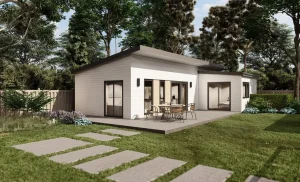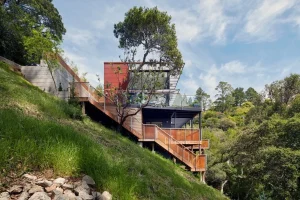The phrase “Leadership in Energy and Environmental Design” can be shortened to “LEED,” which is an abbreviation. The LEED certification program evaluates the design and construction of buildings in terms of environmental factors such as access to public transportation and responsible land use, energy efficiency, water usage, air quality, and the choice of building materials. These aspects are taken into account during the evaluation process.
The United States Green Building Council is the organization that is responsible for sponsoring the LEED program (USGBC). There are four levels of LEED certification that can be bestowed upon building projects that take part in the program, and each level is dependent on the total points earned:
• 40–49 points are awarded to LEED Certified Buildings.
• 50–59 points are awarded to LEED Silver buildings.
• The range of points awarded for LEED Gold certification is 60–79.
• Buildings that qualify for LEED Platinum have earned 80 points or more.
Why Certify With LEED?
The LEED certification program is currently the most prominent example of its kind on a global scale. Achieving LEED certification is evidence that ecologically friendly building techniques have been followed. The image of a building’s owner and a contractor that designs and produces LEED-certified structures can both receive a significant boost as a result of this. A history of successfully completing LEED-certified buildings can assist a builder in gaining a reputation as an industry leader within the construction sector.
In addition to its benefits for public relations, LEED certification may also have significant financial and other advantages. For instance, the United States Green Building Council (USGBC) claims that “LEED buildings enjoy faster lease-up rates and may qualify for a range of benefits, including tax rebates and zoning exemptions.” They also maintain more incredible property prices, which encourages an increase in the number of commercial construction companies working in the sector. LEED accreditation can be beneficial to residential construction companies, as it can help homes sell more quickly and for a better price.
When a home is built in accordance with LEED standards, the builder may be eligible for tax benefits. This is done in order to compare the two types of homes within the same area.
Some evidence suggests that using LEED can assist a construction company in being productive and profitable even during periods of slow economic expansion. According to Eco Brooklyn Inc., “the growth of LEED-certified buildings also appears to be recession-proof.” The overall square footage of LEED-certified buildings increased by 14 percent despite the dramatic decrease in a new construction that was caused by the collapse of the real estate bubble.
Benefits of LEED Certification
Benefits to finances, the environment, and human health that come with obtaining a LEED certification include tax breaks, the ability to recruit tenants, cost savings in operational areas, decreased energy consumption and carbon emissions, and the accomplishment of ESG goals. The following chart outlines these advantages.
1. Tax incentives
The LEED certification makes a building eligible for certain tax credits, which is one of the financial benefits of obtaining this certification. LEED (Leadership in Energy and Environmental Design) incentive programs have been established in a number of states, including Maryland, New Mexico, New York, and Virginia, with the intention of rewarding buildings and communities that make an effort to live more sustainably within those states. Visit the Database of State Incentives for Renewables & Efficiency to learn more about the environmentally friendly incentives that are available in your state (DSIRE).
In light of Vice President Biden’s declared intention to promote the adoption and implementation of environmentally friendly technologies, new tax incentives for commercial buildings and construction are underway. You may learn more about the proposed tax incentives for energy-efficient buildings by reading the article that follows.
2. Save money on operational costs
Buildings that have earned the LEED certification have lower operating costs. According to the website of the USGBC, LEED-certified buildings reported savings totaling $1.2 billion in energy costs, $715 million in maintenance costs, $149.5 million in water costs, and $54.2 million in waste costs between the years 2015 and 2018.
3. Attract tenants
The capacity of a building to recruit tenants is another one of the financial benefits that come with being LEED certified. According to the research conducted by the USGBC, the vacancy rates of green buildings are 4% lower than those of non-green properties. Additionally, LEED-certified buildings have the highest rentals and lease-up rates, which can be up to 20 percentage points higher than the average.
Within LEED-certified buildings, improved rates of recruitment and retention of employees, as well as increased staff productivity, have been documented. This may explain why.
4. Improve indoor air quality
In order to achieve LEED certification, one of the primary goals is to develop a building that provides a healthy environment for everyone who works, lives in, or visits the facility. Better indoor air quality is one of the health benefits that come along with earning a LEED certification. Buildings that have earned the LEED certification have better air quality and greater access to natural light and do not contain any potentially dangerous chemicals included in some paints and finishes. Those who visit your facility frequently and have health conditions such as asthma, respiratory allergies, depression, or stress may benefit the most from an improvement in the building’s indoor air quality.
Improve LEED-Certification Score
To begin, install lights and appliances that use less energy, waste management systems that are more effective, water-saving faucets and toilets, solar- or wind-energy systems, air scrubbers, and any other components that can assist in lowering the overall carbon footprint of your building.
After completing the necessary adjustments, you can submit an online application for LEED certification.
Interested in Becoming LEED certified?
Contact Superb Engineer if you are considering pursuing LEED certification so that you can get started right away and enjoy the many financial, environmental, and health benefits that LEED certification offers. It is only possible to earn LEED certification with the assistance of a reliable partner. Suppose your facility is in need of initiatives related to renewable energy and energy efficiency. In that case, the team of specialists at Superb Engineer will walk you through the processes of designing and building your project. Our team will concentrate on developing the one-of-a-kind solutions your building needs to obtain LEED certification and improve its overall sustainability.



